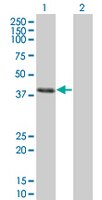ST1523 Sigma-AldrichAnti-CLN3 Mouse mAb (1G10)
This Anti-CLN3 Mouse mAb (1G10) is validated for use in Immunoblotting for the detection of CLN3.
More>> This Anti-CLN3 Mouse mAb (1G10) is validated for use in Immunoblotting for the detection of CLN3. Less<<Sinónimos: Anti-Ceroid-Lipofuscinosis Neuronal 3
Productos recomendados
Descripción
| Replacement Information |
|---|
Tabla espec. clave
| Species Reactivity | Host | Antibody Type |
|---|---|---|
| H | M | Monoclonal Antibody |
| References |
|---|
| Product Information | |
|---|---|
| Form | Liquid |
| Formulation | In PBS, pH 7.2. |
| Preservative | None |
| Quality Level | MQ100 |
| Physicochemical Information |
|---|
| Dimensions |
|---|
| Materials Information |
|---|
| Toxicological Information |
|---|
| Safety Information according to GHS |
|---|
| Safety Information |
|---|
| Product Usage Statements |
|---|
| Packaging Information |
|---|
| Transport Information |
|---|
| Supplemental Information |
|---|
| Specifications |
|---|
| Global Trade Item Number | |
|---|---|
| Número de referencia | GTIN |
| ST1523 | 0 |
Documentation
Anti-CLN3 Mouse mAb (1G10) Ficha datos de seguridad (MSDS)
| Título |
|---|








